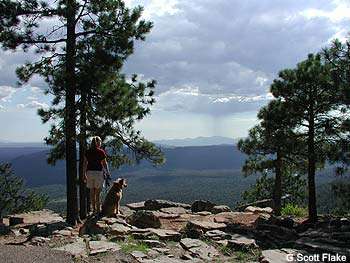The Mogollon Rim
category : Landmarks
 The Mogollon Rim, Arizona's mighty backbone, is an epic in natural, human history.
The Mogollon Rim, Arizona's mighty backbone, is an epic in natural, human history.It is a wilderness rampart of ethereal beauty, carved majestically into unmatched proportions. The Rim Road itself is a twisting, graveled legacy to settlers and cavalry tenacity. With only minor changes, much of General Crook's road is still being used today. All of the gorges have one thing in common. Exposed walls of horizontally layered, sedimentary rocks indicate a great upheaval took place, attesting to the dynamic discomforts of a young and vigorous earth millions of years ago.
In geology, an escarpment is a transition zone between different physiogeographic provinces that involves an elevation differential, often involving high cliffs. Most commonly, an escarpment, also called a scarp, is a transition from one series of sedimentary rocks to another series of a different age and composition. In such cases, the escarpment usually represents the line of erosional loss of the newer rock over the older.
There are escarpments on other planets besides Earth. They are believed to be created when the crust contracts; as a result of cooling.

The Mogollon Rim was uplifted eons ago. Once it marked the shore of a vast inland sea that covered much of southern Arizona. An east-west cliff, the Rim crosses nearly half the state. Climatic conditions changed radically as this one great block of sea bottom, encompassing portions of southern Utah, northern Arizona, the southwest corner of Colorado and the northwest corner of New Mexico, continued to rise. It is the southern margin of the Colorado Plateau, stretching for more than two thirds of the way across central Arizona. Sweeping from northwest to southeast, into New Mexico, it is more than 200 miles long.
Simply stated, the Rim is of structural origin and exposes for examination a series of sedimentary plateau rocks which have been deposited upon one another more or less uniformly during the Paleozoic Age.
From Pine to Young, the Rim's butressed face is rarely less than a near vertical drop of 1,200 feet. At many overlook points its height is close to 2,000 feet above the mountains which stretch across Tonto Basin.
South of Show Low the steep scarp is again blanketed by comparatively recent volcanism. Forming the White Mountains, the once molten blanket covers much evidence of the Plateau's edge as one travels on into New Mexico.
Central Arizona is dependent upon the storm patterns which drive in from the Pacific and come up from the Gulf of Mexico. The clouds release their burden of moisture when they struggle to rise over this huge wall. The top of the Rim flows into the Little Colorado, and all runoff below the backbone flows into the Verde, the Salt, and the Gila rivers.
Around 1600, the Rim country and adjacent mountains in New Mexico became known as the Mogollons, named for Juan Ignacio Flores Mogollon, a Spanish governor and captain general of New Mexico which was a portion of New Spain.
Come visit us in Arizona, Arizona